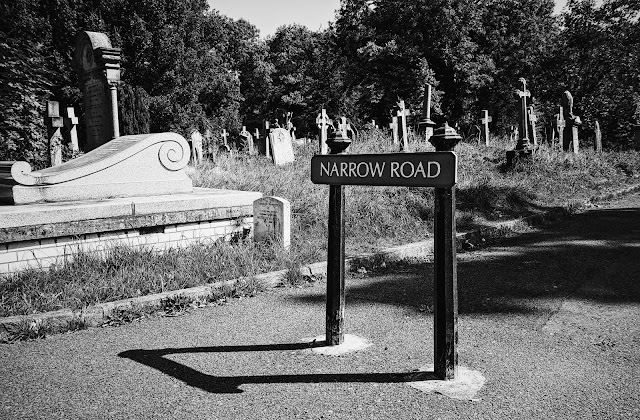Abney Park: a hidden treasure in north London
A serotinal morning announces itself by blending
extant estival greens with emerging autumnal reds. Perfect start for a
Covid-delayed tour of London’s Magnificent Seven. These are Victorian-era
cemeteries that were created to ease pressure on parish burial grounds.
It’s logical that as a north London resident I kick
off at Abney Park, a graveyard opened in 1840, in nowadays trendy Stoke
Newington. I don’t spend much time inside, though. I’m so used to these
grounds, having found them by chance many years ago, on one of my many cycling
jaunts. During the first lockdown in 2020 Abney was one of the two places,
along with nearby Clissold Park, my girlfriend and I frequented.
Today I come across early-rising runners, friendly
dog-walking strangers and school-age children following anxious-looking
parents. Abney’s location serves as a quiet short cut between Stoke Newington
High Street’s hustle-bustle and Stoke Newington Church Street’s café life with
the added bonus of chancing upon famous graves.
Like those belonging to the non-conformists buried
here. These were rebels who defied the ways of the Church of England and
refused to align with a particular Christian denomination. The chapel (derelict
and rundown, though it is) was designed in a manner that showed no bias towards
a single Christian sect.
In addition, if like me, you are into the music of
the late singer Amy Winehouse, you’ll be interested to know that her video “Back
to Black” was partly shot here.
With the sun beginning to beat down on the pavement
and my stomach rumbling, I hop back on my bicycle and head off for my second
destination: Tower Hamlets Cemetery Park.
No matter which route I choose, everywhere is
bumper-to-bumper. The start of the academic year, road closures and the
proliferation of LTNs (low traffic neighbourhoods, a polarising issue if ever I
saw one) means that from Amhurst Road and all the way down Mare Street to Roman
Road, I have to zigzag my way around buses, lorries and cars.
Some years ago I came up with a moniker for this
area: the Hipster Republic of North, North-eastern and Eastern London. Its
borders have changed slightly (gentrification works in mysterious ways), but
the core of it remains the same. It starts in N16 Stamford Hill and continues
through Stokey, Dalston, Hackney, Hoxton, Homerton and Shoreditch. From £5
bowls of cereal to ironic beards, from zany and thought-provoking graffiti to
checked shirts, this is the new, creative (and some might say, overpriced) London.
One of the tell-tale signs that lets you know you
have arrived in Hipster Land is the frames you see either on the road or
parked. I’ve been dipping in and out of Laurent Belando’s excellent book, Urban
Cycling, so I’m able to recognise some of the specimens. The bicycle par
excellence in these parts is the fixie, or its close relative, the single
speed two-wheeler. Understandable when you notice how flat most of east London
is.
But it’s not just the road surface that contributes
to the ubiquitousness of these machines. Both fixie and single speeds are
fashion statements. Their cultish and aesthetic appeal is all part of the
phenomenon I’ve come to describe as “the individualisation of cycling” (some
people would call it “fetishisation”). A bicycle is not just a bicycle. A bicycle
is an extension of a rider’s individuality.
Furthermore, there’re also the professions.
Fixie/single speed owners tend to belong to that turn-of-the-century cabal that
spread slowly through previous no-go areas in east London (I still remember
when someone told me Mile End was known as “Knife End”) bringing rents and
house prices up. They are the artistic directors, marketing managers, graphic
artists, web designers, performers, project managers, communications and media
managers. Of course, their bikes have to say something about them in the same
way the brands they create say something about their company.
Following hot on the (w)heels of the fixie and
single speed come the road bike, porter bike and vintage two-wheeler. Today I spot
an equal number of these frames on the road. From just past Hackney Empire to
Old Ford Road, off Cambridge Heath Road, they seem to be everywhere.
Out of the three, it’s both the porter and vintage
bikes I’ve got a soft spot for. Road bikes, or “racing bikes” leave me cold.
Perhaps, it’s their aggressive look, too much Tour de France, incongruous on
these narrow streets.
The porter and vintage bikes, on the other hand,
invite effortless elegance and style. Today I see a lot of what was formerly
known as girls’/women’s bicycles and have been thankfully re-baptised as “step-thru
bikes”. Just a clever way of convincing gents that they don’t have to swing their
legs over their seats the whole time to prove they’ve got a pair.
Rolled-up yoga mats poke out of baskets
sitting at the front of porter bicycles. In others, pooches sit comfortably, a
gentle breeze ruffling their hair. In open defiance to speed or terrain, porter
and vintage bikes are the non-conformists of our age. Perhaps a place at Abney
is already waiting for them when they reach the end of their cycle.














